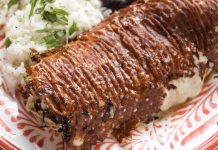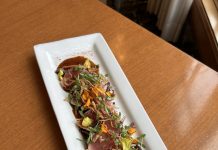
When people think of the various paths to culinary success, few imagine the U.S. Navy as a starting point. But that is exactly where Tyler Benson and Benjamin Mantica got their start. The founders of the seven-month-old Fort Street Galley in downtown Detroit met while serving in the Navy and named their project Galley Group — a nod to the term for a kitchen aboard a vessel. While touring the world at sea, the duo would venture to shore to try different food vendors. Upon returning to the states, they were eager to replicate this model of sampling various cuisines at once. What they wanted was a bold concept that pushed diners to try something different.
Benson and Mantica came up with a business model that pays homage to Silicon Valley tech incubators: They would provide the space, the marketing, and the overhead in exchange for a percentage of the revenue from each of the restaurants within the hall. The hope is that after one year, a restaurateur can develop enough customers — and capital — to be able to establish their own brick-and-mortar business. Galley Group’s first food hall opened its doors in 2015 in Pittsburgh, followed by another in the same city in 2017, and then one in Ohio in 2018. This summer, they plan to launch in Chicago and in Minneapolis. Sure, it’s unique and even admirable — but how is the food from these newbie restaurateurs? Simply put, amazing.

The Detroit space features four concepts: Allenby serves Mediterranean fare; Lucky’s offers what they call “healthy” barbecue; Isla centers on Filipino food; and Table focuses on comfort food like shrimp hush puppies. The space is situated on the ground floor of the Federal Reserve Building and features a wide range of seating options — including long wooden tables, curtained-off areas for private parties, and plush couches near the windows. In the middle of all this sits a bar called Magpie where bartenders whip up unique cocktails.
I recommend starting with Lucky’s deviled eggs with Wagyu beef bacon crust. Each egg is perched on a tiny stand, making it look similar to a miniature Wimbledon trophy. And while the presentation is wow-worthy, it’s the taste that really impresses. Lucky’s also makes a can’t-be-missed beet carpaccio. Yes, you read that right. The veggie-forward carpaccio is the perfect example of Lucky’s taking the concept of barbecue and making it playful yet healthy.
Allenby, which is run by two chefs who used to work at Selden Standard, serves a perfect chicken schnitzel sandwich — it was so good, my friends and I fought over the last bite. It is flavored with sesame seeds, aioli, and hawaij, a Yemenite Jewish spice that contains a blend of cumin, coriander, turmeric, black pepper, and cardamom. I suggest pairing the dish with either the slightly sweet eggplant hummus or the light and zesty and lemony shishito pepper hummus.
At Magpie, I ordered two cocktails. The Kyoto Special Line was made up of corn whiskey, Bushido sake, brose, lemon, and grapefruit. It had just enough tartness and was very refreshing. Next, I tried the Menace Illin,’ which is made with mezcal, ginger-pineapple sherbet, cinnamon, and lemon. This smoky, slightly spiced sip is not to be missed.
But the real star at Fort Street Galley is the Filipino restaurant Isla, helmed by chefs JP Garcia and Jacqueline Joy Diño. As a group, our top dish of the night was the lechon kawali. The dish is comprised of crispy pork belly served with dinuguan sauce — a robust, dark gravy made with pig blood, garlic, chili, and vinegar. Another dish to try: the lumpia, a Filipino staple that is similar to a spring roll. Their fresh veggie version is topped with peanut garlic sauce and jicama. While I have eaten Filipino food several times, this was by far the best. So good, that I kept going back to the chefs to ask how they pulled off the balance of sweet and savory flavors. After pestering them with questions, one of Isla’s employees kindly came over and gave us a history on Filipino cuisine.
We ended the meal with Isla’s ube cake, made with purple yam. Then, added an order of the buko halo-halo, a delightful ice cream and sweetened bean dessert served in a coconut shell. The buku halo-halo was so colorful and layered — like all the food at Fort Street Galley — that my friends and I were tempted to simply stare at it in admiration. But Diño had a different, more practical recommendation. “It will taste better if you mix it all together,” she said, offering us advice that seems to summarize the very purpose of any great food hall: bringing people together and blurring boundaries.
Fort Street Galley, 160 W. Fort St., Detroit; 313-230-0855. B, L, & D Daily.
A History of Flavor
While other cuisines like Chinese or Indian have long been a part of America’s culinary landscape, Filipino cuisine has often been ignored by the masses. Well, no longer. Filipino restaurants are now popping up throughout the country and earning well-deserved acclaim.
Broadly speaking, Filipino food is a mixture of Malay and Chinese-style, fused with influences from centuries of interactions with Arab traders and the Philippines having been under Spanish occupation for over 200 years. It’s this amalgamation of flavors that makes Filipino food so unique. While some countries have tried to push aside outside culinary influences, Filipino food blends it all and manages to make it entirely its own.
Many Filipinos came to Detroit in the 1960s during a time of political unrest in their country. According to the 2010 census, there are around 20,000 Filipinos in metro Detroit. While there has always been a strong population, there haven’t been many Filipino restaurants. In 2014, Dorothy Hernandez (a former Hour Detroit staffer) and Jake Williams started a popular Filipino pop-up called Sarap, which means “delicious” in the native language of the Philippines. Today, Isla is the city’s only Filipino restaurant.
|
|
|




















